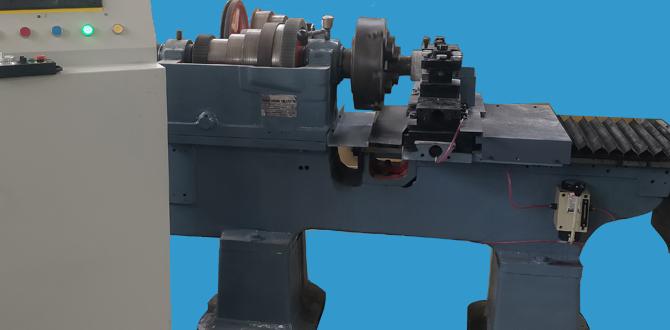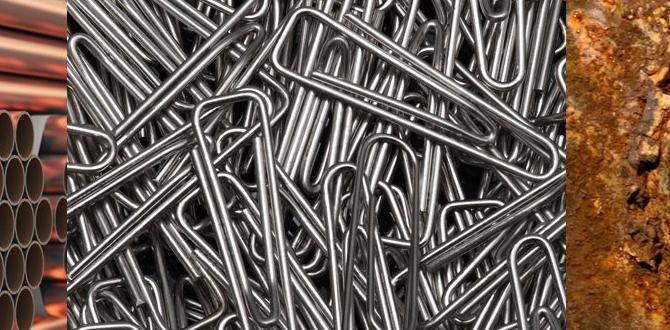Quick Summary: Get extended tool life from your 1/8 inch carbide end mill when cutting nylon. Proper speeds, feeds, sharp tooling, and optimal chip evacuation are key. This guide details proven methods for maximizing your nylon machining, ensuring consistent results and saving you time and money.
Working with plastics, especially something as versatile as nylon, can be a fantastic way to bring your creative ideas to life. Whether you’re a hobbyist looking to make a custom part for a robot, an apprentice learning the ropes of CNC machining, or a seasoned maker pushing the boundaries of your workshop, understanding how to effectively cut nylon is a valuable skill. One of the most common challenges, however, is getting tools to last. Specifically, a 1/8 inch carbide end mill, a miniature powerhouse for detailed work, can wear out surprisingly quickly if not used correctly. This isn’t just frustrating; it can lead to poor cut quality and wasted materials. But don’t worry! With the right knowledge and a few simple adjustments, you can dramatically improve the lifespan of your carbide end mill when machining nylon. We’ll walk through the essential steps to achieve longer tool life, ensuring your projects run smoothly and efficiently.
Why Nylon is a Unique Material for Machining
Nylon, a common thermoplastic, is adored for its strength, durability, and low friction. It’s used in everything from gears and bearings to textiles and food packaging. However, when you bring it to the milling machine, its unique properties can become a bit of a challenge. Unlike metals, nylon has a lower melting point and tends to “gum up” or melt rather than chip cleanly. This gummy behavior can load up the flutes of your end mill, increasing friction, heat, and ultimately, tool wear. Understanding this makes it clear why a standard approach used for metal might not work well for nylon.
The 1/8 Inch Carbide End Mill: A Closer Look
The 1/8 inch carbide end mill is a staple for detailed machining. Its small diameter allows for intricate designs, tight corner radiuses, and precise feature creation. Carbide is a great choice for this size because it offers superior hardness and wear resistance compared to high-speed steel (HSS). However, even carbide has its limits, especially when dealing with sticky materials like nylon. For cutting nylon, it’s often recommended to use end mills designed for plastics or softer materials, but a standard 1/8 inch carbide end mill can still perform admirably if you follow best practices. Key features to look for include a bright, polished finish on the flutes to help prevent material buildup and a geometry that allows for efficient chip evacuation.
Understanding Chip Load and Surface Speed
For any machining operation, understanding chip load and surface speed is crucial. This is especially true when machining nylon with a small diameter tool like a 1/8 inch end mill.
- Surface Speed (SFM or m/min): This is how fast the cutting edge of the tool is moving relative to the workpiece. For nylon, you typically want a much higher surface speed than for metals. This is because nylon can melt easily, and a higher speed helps to shear the material cleanly rather than melt it.
- Chip Load (IPM per tooth or mm/tooth): This is the thickness of the chip that is being removed by each cutting edge of the tool. It’s directly related to how much material is being cut at any given moment. For nylon, you want a chip load that is sufficient to create a distinct chip, not just a rub or melt. Too light a chip load can lead to rubbing and excessive heat, while too heavy a chip load can overload the tool and the machine.
When you combine these two factors, you get your cutting speed (G-code S command) for your CNC machine. A common formula is: Spindle Speed (RPM) = (Surface Speed 3.82) / Tool Diameter (inches).
Key Factors Affecting Tool Life in Nylon
Several interconnected factors dictate how long your 1/8 inch carbide end mill will last when cutting nylon. Getting these right means longer tool life, cleaner cuts, and less frustration.
- Cutting Speed (RPM): As mentioned, the rotational speed of your spindle is critical. Too slow, and you risk melting; too fast, and you might overheat an already stressed tool.
- Feed Rate (IPM): This is how fast the cutter moves through the material in inches per minute (or mm/min). It needs to be synchronized with your spindle speed to achieve the correct chip load.
- Tool Geometry: The design of the end mill matters. Polished flutes, the number of flutes, and the helix angle all play a role in how chips are cleared and how much heat is generated.
- Coolant/Lubrication: While not always used for nylon, some form of cooling or lubrication can be beneficial, especially for minimizing heat buildup.
- Material Properties: Different grades of nylon have slight variations in hardness and melting point, which can affect machining.
- Machine Rigidity: A stable machine with minimal vibration will always yield better results and extend tool life.
Proven Strategies for Maximizing 1/8 Inch Carbide End Mill Life in Nylon
Now, let’s dive into the practical steps you can take to ensure your 1/8 inch carbide end mill enjoys a long and productive life when machining nylon. These strategies are designed to be easily implemented by beginners and experienced machinists alike.
1. Optimal Speeds and Feeds: The Foundation
This is arguably the most important factor. Getting your speeds and feeds dialed in correctly prevents melting and excessive wear.
- Start with Recommended Values: Consult manufacturer datasheets or online resources for recommended starting parameters for machining nylon with carbide end mills. While a 1/8 inch end mill is small, these general guidelines can provide a solid baseline. For example, a typical starting point for a 1/8 inch 2-flute carbide end mill in nylon might be around 18,000-24,000 RPM and a feed rate that results in a chip load of approximately 0.001″ – 0.002″ per tooth.
- Calculate Your Feed Rate: Use the chip load to determine your feed rate: Feed Rate (IPM) = Spindle Speed (RPM) Number of Flutes Chip Load (inches/tooth).Example: For a 2-flute end mill at 20,000 RPM with a chip load of 0.0015″ per tooth:
Feed Rate = 20,000 RPM2 * 0.0015″ = 60 IPM. - Listen and Observe: The best way to fine-tune is to pay attention.
- If you hear a high-pitched squeal, you might be going too fast or not taking enough material (poor chip load), causing rubbing.
- If the nylon is melting and packing into the flutes, you’re likely going too slow in RPM (not shearing cleanly), or your feed rate is too low for the RPM (too little material per rotation).
- If you see long, stringy chips, your feed rate might be too high for the RPM, or you need better chip evacuation. Ideally, you want small, broken chips.
- Adjust Gradually: Make small adjustments to your feed rate or RPM. A slight increase in feed rate (e.g., by 5 IPM) or a small increase in spindle speed (e.g., by 500 RPM) can often make a significant difference.
2. Choosing the Right End Mill
Not all 1/8 inch carbide end mills are created equal when it comes to nylon.
- Number of Flutes: For plastics like nylon, 2-flute end mills are often preferred. They provide more aggressive chip evacuation compared to 3 or 4-flute tools, which can help prevent melting and buildup.
- Helix Angle: A higher helix angle (e.g., 30-45 degrees) tends to provide a sharper cutting action and better chip removal, which is beneficial for plastics.
- Coatings: While not always necessary for nylon, coatings like TiN (Titanium Nitride) or DLC (Diamond-Like Carbon) can offer additional hardness and reduce friction, potentially extending tool life. However, a standard bright finish is often sufficient.
- Polished Flutes: End mills with highly polished flutes are crucial for plastics. This smooth surface reduces the tendency for melted plastic to stick to the tool.
3. Effective Chip Evacuation
This is critical for preventing heat buildup and maintaining a clean cut.
- Air Blast: A steady stream of compressed air directed at the cutting zone is highly effective. It blows chips away from the tool and workpiece, preventing recirculation and reducing heat. This is often the simplest and most effective cooling method for nylon.
- Minimum Quantity Lubrication (MQL): A fine mist of specialized cutting fluid specifically designed for plastics can help lubricate and cool. Use sparingly, as too much can create a mess and attract dust. Ensure the MQL fluid is compatible with nylon and won’t degrade it. For example, using an oil-based coolant that can be vaporized and delivered as a mist is often effective. Learn more about MQL systems for guidance on their application.
- Stepover and Stepdown Parameters:
- Stepover: The amount the tool moves sideways for each pass. A smaller stepover (wider cut) can sometimes lead to less dramatic chip load per flute, but a more aggressive stepover (narrower cut) might manage heat better if combined with appropriate speeds. Experimentation is key. For 1/8 inch end mills, keeping the radial depth of cut (stepover) at around 25-50% of the tool diameter can be a good starting point, but for nylon, you might find that a smaller stepover with a higher axial depth of cut (stepdown) works more efficiently.
- Stepdown (Axial Depth of Cut): The amount the tool cuts into the material vertically. For 1/8 inch end mills in nylon, avoid taking overly deep cuts. For roughing, a stepdown of 0.050″ to 0.100″ might be suitable, depending on the rigidity of your setup. For finishing, reduce this significantly to 0.010″ – 0.020″.
4. Tool Holder and Machine Rigidity
A wobbly setup is a fast way to dull and break tools.
- Tight Tolerances: Ensure your tool holder (collet or chuck) is clean and provides a secure grip on the end mill shank. A runout of more than 0.001″ can drastically reduce tool life and cut quality.
- Minimal Overhang: Keep the cutting portion of the end mill as close to the collet as possible. A long tool overhang increases vibration and reduces cutting forces, leading to chatter and premature wear. For a 1/8 inch end mill, try to keep the engagement no more than 1/2 inch to 3/4 inch if possible.
- Machine Stability: Ensure your machine is on a stable surface and that there are no loose parts or excessive play in the axes.
5. Cutting Strategies for Nylon
How you approach the cut can make a big difference.
- Climb Milling vs. Conventional Milling:
- Climb Milling: In climb milling, the cutter rotates in the same direction as its feed into the material. This effectively pulls the chip away and tends to produce a smoother surface finish and longer tool life, especially in softer materials like nylon. It’s generally the preferred method for plastics.
- Conventional Milling: The cutter rotates against the direction of feed. This tends to create more friction and can lead to a rougher finish and increased tool wear in nylon.
Most modern CNC controls will default to or make climb milling easy to implement. Look for a `G41` or `G42` cutter compensation command in your G-code for more advanced control, but simply ensuring your CAM software is set for climb milling is the easiest way.
- “On-Surface” vs. “In-Pocket” Milling: When milling a pocket, you can either mill the walls of the pocket directly (plunge into the side, then mill around – this is climb milling) or simply plunge down to depth and mill into the material. For chip evacuation and less stress on the tool, plunging into the side of a pocket with a climb milling strategy is often best if your tool can handle it.
- Finishing Passes: If you’re aiming for a very precise surface finish, consider a dedicated “finishing pass” with a lighter depth of cut and potentially a slightly faster feed rate. This removes a thin layer of material, cleaning up any minor imperfections left by the roughing pass.
Troubleshooting Common Issues
Even with the best practices, you might encounter a few snags. Here’s how to address them:
Issue: Nylon is Melting and Clogging the End Mill
Cause: Insufficient cutting speed (too slow RPM or too fast feed), poor chip evacuation, or excessive friction.
Solution:
- Increase spindle speed (RPM).
- Increase feed rate (to achieve a larger chip load, but not so much that it overloads the tool).
- Improve chip evacuation with a stronger air blast.
- Ensure you are using a tool with a high helix angle and polished flutes.
- Try a finishing pass with a different strategy to clean up melted material.
Issue: Chattering or Vibration
Cause: Tool overhang too long, machine rigidity issues, incorrect feeds/speeds, dull tool.
Solution:
- Reduce tool overhang by using shorter end mills or a stubbier tool holder.
- Ensure your machine is well-maintained and stable.
- Listen to your tool path – sometimes a slightly different stepover or stepdown can break up harmonic vibrations.
- Check if your tool is dull and replace it if necessary.
Issue: Poor Surface Finish
Cause: Tool is dull, insufficient chip evacuation causing re-cutting of chips, incorrect finishing parameters, or excessive runout.
Solution:
- Use a sharp, new end mill for finishing.
- Ensure good chip evacuation throughout the cut.
- Perform a dedicated finishing pass with a small depth of cut (e.g., 0.010″ – 0.020″) and an appropriate feed rate.
- Verify tool holder runout is minimal.
Maintaining Your End Mills for Longevity
Even the toughest carbide tools benefit from care:
- Inspection: Before each use, visually inspect your end mill for any signs of wear, chipping, or material buildup. A magnifying glass can be helpful.
- Cleaning: After use, thoroughly clean your end mills with a brush and appropriate solvent to remove any nylon residue. This prevents material from hardening and causing issues on the next run.
- Proper Storage: Store end mills in a clean, dry place, ideally in a tool holder or a protective case, to prevent damage to the cutting edges.
Table: Recommended Starting Parameters for 1/8 Inch Carbide End Mill in Nylon
These are general guidelines. Always start conservatively and adjust based on your specific material, machine, and tooling.
| Operation | End Mill Type | Spindle Speed (RPM) | Feed Rate (IPM) | Chip Load (inch/tooth) | Axial Depth of Cut (inch) | Radial Depth of Cut (Stepover) (%) | Cooling |
|---|---|---|---|---|---|---|---|
| Roughing | 2-Flute, High Helix, Polished | 18,000 – 24,000 | 40 – 90 | 0.001 – 0.002 | 0.050 – 0.100 | 25% – 40% | Air Blast |
| Finishing | 2-Flute, High Helix, Polished | 20,000 – 25,000 | 60 – 120 | 0.0005 – 0.001 | 0.010 – 0.020 | 10% – 20% | Air Blast |
Note: When calculating feed rate for finishing, prioritize a very light chip load to achieve a smooth surface. The higher feed rate at







